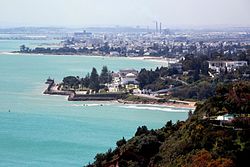Sidi Bou Said
This article needs additional citations for verification. (September 2014) |
Sidi Bou Saïd
سيدي بو سعيد | |
|---|---|
Suburb | |
 Carthage Palace from Sidi Bou Said | |
| Coordinates: 36°52′N 10°20′E / 36.867°N 10.333°E | |
| Country | |
| Governorate | Tunis Governorate |
| Government | |
| • Type | Unitary Semi-Presidential Republic |
| • Mayor | Raouf Dakhlaoui [1] |
| Population (2014) | |
| • Total | 5,911 |
| Time zone | UTC1 (CET) |
| Area code(s) | 36° 52′ 0″ N, 10° 20′ 0″ E |
Sidi Bou Said (Template:Lang-ar ) a town in northern Tunisia located about 20 km from the capital, Tunis.

Named for a religious figure who lived there, Abu Said al-Baji, it was previously called Jabal el-Menar. The town itself is a tourist attraction and is known for its extensive use of blue and white. It can be reached by a TGM train, which runs from Tunis to La Marsa.
Artists
Sidi Bou Said has a reputation as a town of artists. Artists who have lived in or visited Sidi Bou Said include famous occultist Aleister Crowley, Paul Klee, Gustave-Henri Jossot, August Macke and Louis Moillet. Tunisian artists in Sidi Bou Said are members of École de Tunis (painting school of Tunis), such as Yahia Turki, Brahim Dhahak and Ammar Farhat. French philosopher Michel Foucault lived there for a number of years while teaching at the University of Tunis. French author Andre Gide also had a house in the town.
History
In the 12th century/13th century AD Abu Said Ibn Khalaf Yahya al-Tamimi al-Beji arrived in the village of Jabal el-Menar and established a sanctuary. After his death in 1231, he was buried there. In the 18th century Turkish governors of Tunis and wealthy citizens of the latter built residences in Sidi Bou Said.
During the 1920s, Rodolphe d'Erlanger applied the blue-white theme all over the town. His home, Ennejma Ezzahra, is now a museum.
One of the most famous landmarks of Sidi Bou Said is what is known as the “Nejma Zahra” palace, built by the English Count Erlanger, which shows the manifestations of love and beauty reflected in its decorations, angles and ruins. Today it has turned into a museum that displays musical instruments and organizes concerts of classical and Arabic music.[2]
Gallery
-
Typical street with white walls and blue window shades
-
Sidi bou said
-
August Macke Sidi Bou Said painting "View into a Lane"
-
Paul Klee visited Sidi Bou Said in April 1914
References
External links
 Sidi Bou Said travel guide from Wikivoyage
Sidi Bou Said travel guide from Wikivoyage





